Photometric Determination Of
The Rotational Period of Asteroids
 John E. Hoot
John E. Hoot
SSC Observatory
IAU #676
This Earth based view of Vesta was made in infrared
lightwith adaptive optics by the Keck Observatory. It is the most
detailed earth based image ever made of a minor planet and a taste of
things yet to come.
Contents
Why Do We Bother To Measure Asteroid Rotational Periods
Aside from the satisfaction of aquiring emperical information on
our universe for its own sake, asteriods have become a hot topic in
the media because we have recently become aware that asteroid impacts
on Earth have played a very significant roll in the development of
out planet and the evolution and extinction of species. In developing
a better understanding of the composition and keneticdynamics of
asteroids, we will be better prepared to deal with the theat to
Earth, that these bodies present.
Unlike the planets, asteroids exist in large enough numbers that
statistical methods can allow us to gain insights into the evolution
and behavior of asteroids. The population of asteroids for which we
have good orbital data, has grown to approximately 10000 . This has
doubled in the past decade and may more than double in the next 10
years with the applications of robotic telecopic searches and
dedicated amateur asteroid hunters.
With this large a sample, if the spectral, rotational, and orbital
characteristsc of the population were well known, the applicatoin of
statistical methods should yield new knowledge of the families,
origins, composition and evolution of swarm of minor planets that
move within our solar system.
In addition to earth based observation, spacecraft have just
started to visit the minor planets. This space based observation of
asteroids, should provide baseline observations against which we can
calibrate our earth based observations. The linking of space based
observations with earth based observations will allow us to tune our
models and therfore multiply the value of earth based observations.
So far the Galileo
spacecraft has visited Gaspara and Ida. The NEAR spacecraft has
imaged 253 Mathilde
and 433 Eros and will hopefully go into orbit around Eros in February
2000. Additionally, Deep
Space I spacecraft is scheduled to rendevouz with asteroid 1992KD.
And future mission plans include landing on asteroid Neriers. This
agressive investigation of minor planets makes it an exciting time to
be studying the minor planets.
At present, we know the rotational characteristics of only about
700 out of the 10000 asteroids with known orbits. The number of
asteroids for which obervation is needed provides amateurs an
opportunity to make a genuine contribution to the advancement of the
science. The necessary observations are well within the capability of
CCD equiped amateur telescopes.
Asteroid Characteristics
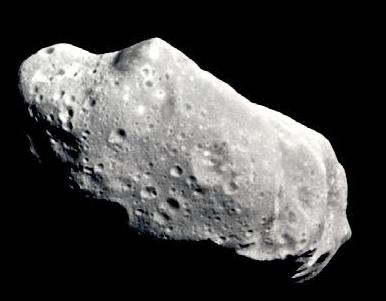 In order to infer a rotational period
from asteroids based on photmetric data, we must have model of
asteroids that explains the variations in reflected light from the
asteroid. In general we assume that:
In order to infer a rotational period
from asteroids based on photmetric data, we must have model of
asteroids that explains the variations in reflected light from the
asteroid. In general we assume that:
- Asteroids are ellipsoidal solid bodies.
- They rotate about their shortest axis
- The axis of rotation is invariant with time
- The albiedo of asteroid is roughly constant
This seems a reasonable set of assumptions. Only a few of the
largest asteroids have enough self gravitation to force the asteroid
to assume a shperical shape. Furthermore, if the asteroid is at all
elastic, over time the conservation of angular momentum will move the
rotational axis to pass though the narrowest part of the body. Baring
collisions or fragmentation during the observation period, the
asteroid's axis and period should remain invariant. Finally, that the
albiedo should remain constant, is perhaps the weakest assumption,
but at least to the first order, observations seem to support this
assumption.
Taken together, I call these assumptions, the spinning spud model,
since such bodies remind me of a potatoe spinning through space.
Spinning Spud Model
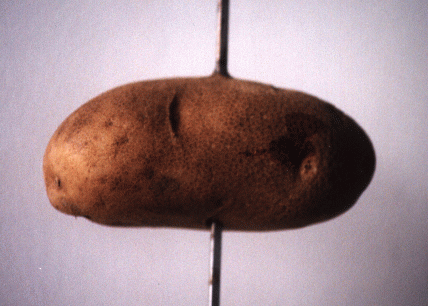
If you meditate a bit on the spinning spud model, illuminated by a
distant point source (the Sun) and think about the total reflected
light a seen by an earth based observer you conclude that:
- The brightness will vary most then the axis of rotation is perpendicular to you line of observation.
- The light curve will have two maxima. One when each of of the longer axis of the ellipisod is perendicular to observer,
assuming the object is viewed at opposition. It gets a bit more complex
when the object is view at other phase angles, but the peaks are still
releated to longest axis being face on to a line that divides the angle
formed by the sun, asteroid and earth..
- The light curve will display two minima, when each of the shorter axis are perpendicular to the observer.
- If the axis of rotation in pointed directly observer, the light curve should show no variation.
These properties of the spinning spud model allow you to infer
much about an asteroids rotation from observation. If observed over
several oppositions, its period of rotation, the orientation of its
pole of rotation, and the ratio of its major and minor axis and, with
color classification, its rough size and shape can be determined.
Asteroid Eros Flyby
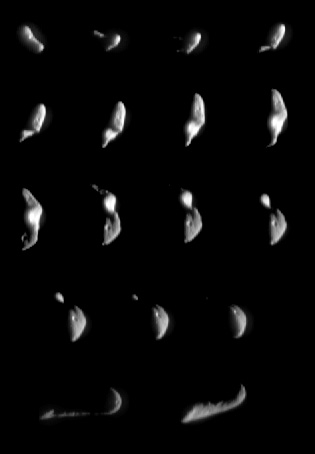
Click on this image to see an animation of the flyby
The recent flyby of asteroid Eros by the NEAR spacecraft provides
confirmation of this model of asteroid behavior.
The Distribution of Periods
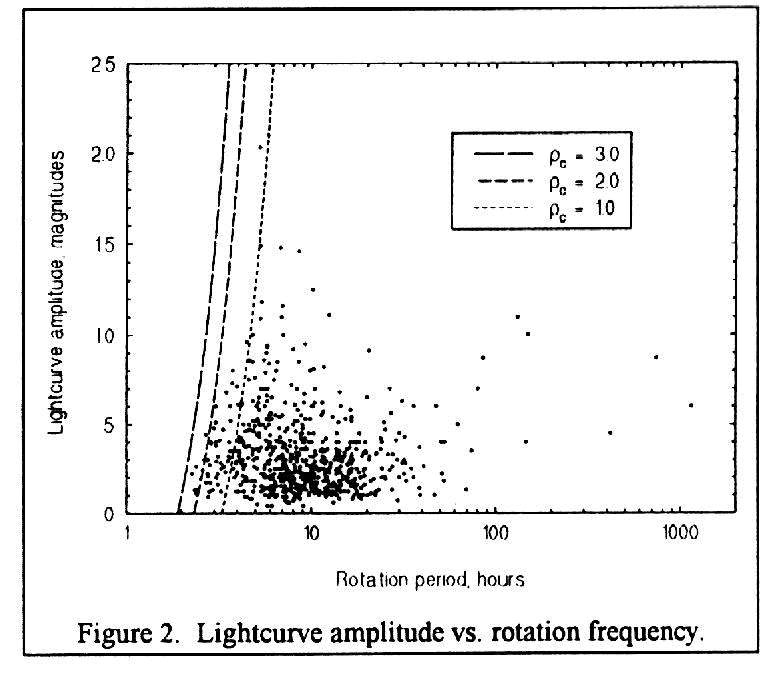 Courtesy of A.W. Harris
Courtesy of A.W. Harris
The graph above shows the rough distribution of rotational periods
vs amplitude of light curves for asteroids with well determined
rotational rates. This scatter plot shows that the range of
rotational rates is clustered around a centroid of about eight hours
duration and the median variation is about 0.2 magnitudes. This puts
the observation of these parameters well withing the range of
amateurs. Most amateur CCD cameras are capable, of making photometic
observations accurate to within 1%. Additionally, for typical
asteroids, photometric observation over a couple of evenings should
be sufficient to determine the rotational period.
This is a area of research where the odds are stacked in favor of
the amateur. There are such an abundance of targets requiring
sustained observation, professional telescope allocation committees
are reluctant to allocate large telescope time for such observation.
Furthermore, under the pressure of shrinking budgets, many
institutions are shutting down sub meter class instruments suited to
this type of observations.
Target Selection Process
It is easiest, and most useful to observe asteroids that are hear
opposition. At this time, they are usually near their brightest. You
should strive to observe them within with 10 degrees of there
opposition. Normal ephemides available from the IAU Minor Planet
Center, Lowell
Obervatory or
other sources contain a column indicating the phase illumination
angle of the asteroid. Another advantage of picking asteroids at
oppostion is that you have the longest available observing time,
since the will transit about local midnight, being visible most of
the night. An excellent list of minor planets near opposition can be
found on a web page maintained by Turbo
Power Software. Another source of brighter asteroids near
opposition is Ron Baalke's Space
Calendar.
To make the largest contribution, you would like to pick an
asteroid for which the period is not well determined. A list of
asteroids for which the period is already known can be found from the
IAU Minor Planet Center's webpage. In practice, if you pick an
asteroid with a number above 1000, you are very likely to
contributing new observations. As a second priority is the
observation of asteroids near opposition for which the pole
orientation is undetermined. You observations can help in making that
final determinations.
Observational Techniques
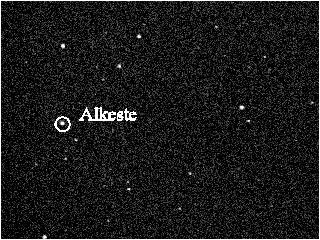 Photometric
observation of minor planets is similar to variable star photometry
performed with CCD cameras. Once you have located your target, you
take a series of images of the object. To see a nighrs worth of
obervations of 124 Alkeste collected into a time lapse animation,
click on the image at
left. You images should be spaced out in time so that you are getting
about 100 observastions per rotation. For an asteroid with a typical
rotation rate, one image every 5 minutes is about right. It is best
if you take a couple of observartion and blink them to get a sense of
the rate and direction of your target's motion relative to background
stars. Then reposition your field of view so that the asteroid will
stay within the frame for the entire night's observing session. This
will allow you to use the same background stars as photometric
references during data reduction and will simplify the differential
photmetry. Photometric
observation of minor planets is similar to variable star photometry
performed with CCD cameras. Once you have located your target, you
take a series of images of the object. To see a nighrs worth of
obervations of 124 Alkeste collected into a time lapse animation,
click on the image at
left. You images should be spaced out in time so that you are getting
about 100 observastions per rotation. For an asteroid with a typical
rotation rate, one image every 5 minutes is about right. It is best
if you take a couple of observartion and blink them to get a sense of
the rate and direction of your target's motion relative to background
stars. Then reposition your field of view so that the asteroid will
stay within the frame for the entire night's observing session. This
will allow you to use the same background stars as photometric
references during data reduction and will simplify the differential
photmetry.
Be sure to synchronize your computer's clock with an accurate time
standard such as WWV, or GPS time signals prior to beginning your
observations. Since we are critically interested in both time and
intensity, using the best standards for both will insure that the
most accurate results.
Be sure that your exposure time does not let the asteroid saturate
your detector. For optimal signal to noise ratios, you want your
peak asteroid flux to be 2/3 to 3/4 of your CCD's maximum dynamic
range. Additionally, you want your star and asteroid images to
cover several pixels. The FWHM should be 4 or more pixels. This
assures that minor variations in pixel sensitivity (even after flat
fielding) will not contribute to large sigmas (errors). If you seeing
or focal lengths are such that you cannot acheive this, go ahead and
slightly defocus your image to obtain a wider point spread function.
If you have access to photometric filters, use at least one of
them to take your measurement. On at least on observation use both B
and V filters or R and V filters to determine color indexs. This
will allow you to reduce your instrumental magnitudes to standard
magnitudes. This will make your observations useful to other
observers and is essential if you wish your results to contribute to
asteroid pole determination. If you do nor have photometric filters,
your observations are still very useful in determining the rotational
period of the asteroid.
You will want to gather data over the course of several
evenings. This will help in several ways. It will provide a longer time
baseline, so that your period can be determined much more accurately.
Additionally, it will allow you to capture different segments of the
rotational light curve, so that a complete curve will be able to be
contructed from your observations. Finally, on any given night, try
to get as long a sequence of observations as cirumstances allow. With a
well aligned telescope and many of the CCD data capture
programs taking multiple sequences of images, you may be able to
capture long sequences of data while you sleep!
Data Reduction
To reduce your observations to data, you will need to process all
of your images identically. You will need to perform dark
subtraction and flat field all of your images. The quality of your
flat fields are critical to obtaining good results. The best flat
fields are obtained by combining many individual flat field images in
a single master flat. Time spent on this effort will reward you
with low systematic errors attibuted to object position in your
frame. Do not do any other prettying up of your image such as
contrast stretching, unsharp masking or filtering. What we are
interested in is the photon count from the asteroid and reference
stars during the image. Any other processing will corrupt this
information.
It is easiest to do differential pohtometry each of your evening's
observations. Select for your reference star a star of appoximately
the same magnitude and color as your asteroid. This will minimize
the extinction effects differential extinction (the tendency of the
atmosphere to attenuate blue more than red at lower elevations) on
your observations. You find out the color and background of your
reference stars easily from the Hipparcos Catalog data available on
the web. Additional reference stars can be found on the LONEOUS home
page. As a good check point, you should also compute the
differential magnitude of other stars in the field. Tabulate your
results to show, Filename, UTC Observation Time, and Differential
Magnidue.
Reduction of your data to just this level is sufficient to
determine periods. If you have the ability to reduce your
differential photometry to UBVI standards, by all means do so.
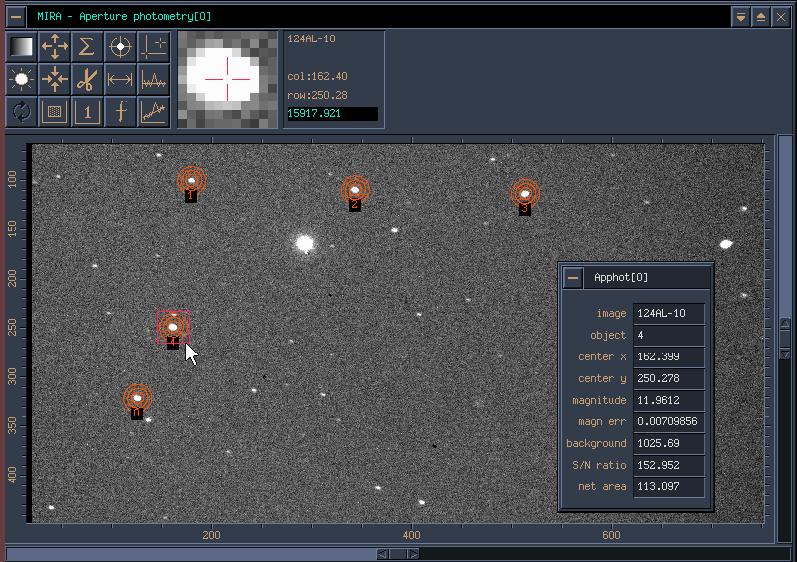
While this data reduction may seem a daughting task, there are
several PC based packages that make this task managable. I use MIRA
to do my data reduction. It allows you to batch process your whole
evening's imagery. It also has an excellent aperature photometry
module that computes magnitudes, extinction coefficients and error
signals and collects the results in a text file that can be quickly
edited for input into a spread sheet or period analysis programs.
If MIRA is beyond your means, you might consider bringing up LINUX
on your PC. This free UNIX clone runs on most PC's. With it running
on your PC your are able to run IRAF. This is the same software used
at Kitt Peak and many other observatories to analyze astromical data.
The IRAF source and object code for LINUX can be downloaded free off
the internet or puchased on CD ROM for a nomial fee. The DAOPHOT
module of IRAF is among the most capable photometric data reduction
programs around.
While you are reducing your data, do not forget to perform the
astometry. While you may not be observing an asteroid on the Minor
Planet Center's critical list. Your observations of position for
each night are important in keeping your asteroid off the critical
list in the future.
Log Time & Differential Magnitude
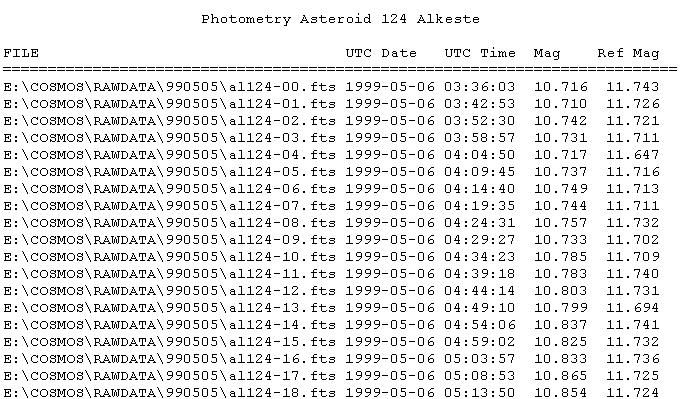
When you are done, you are going to get a file similar to the
fragment shown above. The next step is to import this information
into your favorite spread sheet and graph the data. If all has gone
well you will be looking at a fragment of an asteroid light curve. If
your observations have been stretched out to far in time, you may
want to correct your observation times for light travel time. You
can do this by picking your first night as the reference distance,
and adjusting the obsevation time according to the following formula:

Where
D is expressed in A.U.
T is expressed in Seconds
Estimate Rough Rotational Period
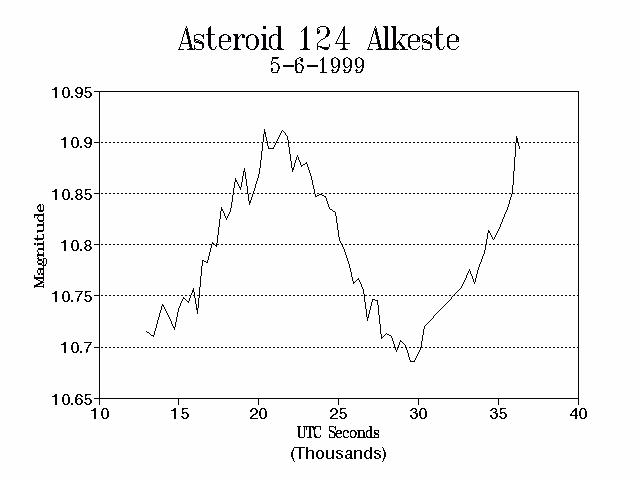
Using your favorite spread sheet program, graph each nights
observation onto a separate transparency. Use the same time scale
for the time dimension and span the same number of relative
magnitudes in the Y dimension. You can now overlay theses
tranparencies looking for a fit, and make your first rough estimate
of the rotation period. From the example above you can see that we
have captured a minima and maxima. Typcially, the asteroid's perdios
will be somewhere around four times this value. In the case we would
guess a period somewhere roughly arround 10 hours.
Determine Exact Period
Alan Harris of JPL has developed a program called Fourier Analysis of Light Curves that will
take multiple light curve fragments and utilizing frequency domain
techniques, determine the most likely period fit to your collection
of light curve data. An explanation of this process in included with
the program available for download here. Once the data has been
formated for input into this program. You run successive trials,
looking for the best period fit.
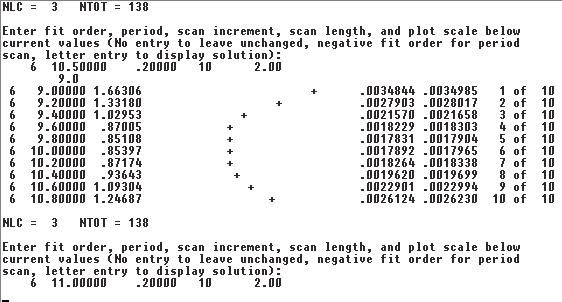
Above is an example of the output of the first run of the data. It
shows that the best fit in the range of 9 to 11 hours is somewhere
between 9.8 and 10 hours, confirming our intuition.
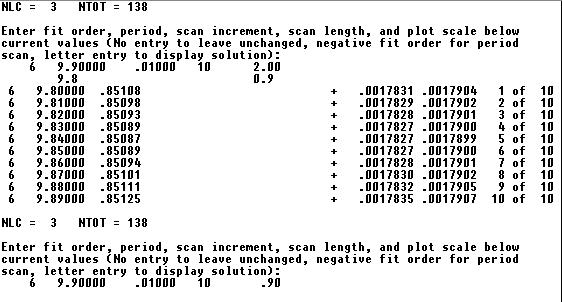
This next run narrows the period more to a value of 9.84hours. A
final solution analysis output by the program will show the estimated
period and the associated uncertainties.
Publishing Your Data
You data is important. Once you have made your observations, share
them with professionals. If you have reduced a significant number of
periods, consider publishing your work in Icarrus, PASP
or Astronomy & Astrophysics. Otherwise,
submit your
observations to A.W. Harris or the Upsalal Asteroid Database
Milking The Numbers
Detailed scientific observation, takes dedication an care. When
you go to the effort of making prolonged observations, you owe it to
yourseld to milk all the data from you work. Be sure to do you
astrometry and submit it to the IAU Minor Planet Center. Additionally,
blink all of your images. You cannot stare at one spot
in the sky for night on end and not get lucky enough to find other
asteroids, or variable stars in you images. Blink all of your
images, note and record new variable stars and other asteroids. Get
to the blinking quickly. If you find a near earth asteroid, it will
be too late to follow up if you wait more than a day or two report
it.
Resources
Asteroid Ephimerides
Asteroids Near Opposition
Table of Know Asteroid Periods
Asteroid Magnitude vs Diameters
Period Calculators
- Buie & Bus, Icarus 100:288-,
- Harris, A.W. “Rotations Rates of Small Asteroids:..” Lunar and Planetary Sci XXVVII (1996)
- Magnusson, “Pole determinations of asteroids” Icarus (ISSN 0019-1035), vol. 103, no. 1, p. 62-66.
- Magnusson, “Analysis of Asteroid Light Curves. I. Databases and Basic Reduction” Astron & Astrophys Sup. 86 45-51 (1990)
- Stellingwerf, “Period Determination Using Phase Dispersion Minimization”, Astrophy. Joun. 224:953-960 (1978)
|
